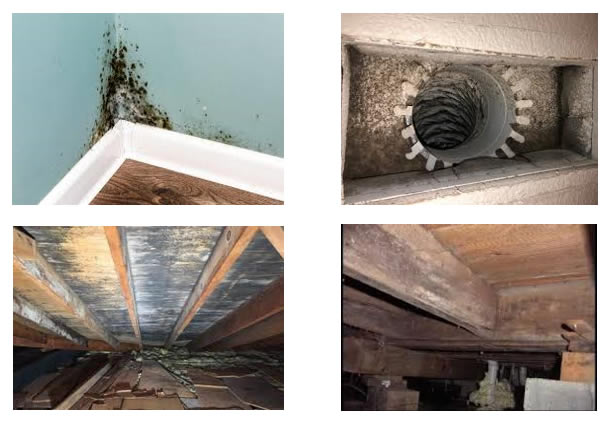Molds are part of the natural environment. Outdoors, molds play a part in nature by breaking down dead organic matter such as fallen leaves and dead trees, but indoors, mold growth should be avoided. Molds reproduce by means of tiny spores that are invisible to the naked eye and float through the air. Molds can have a big impact on your indoor air quality.
Mold may begin growing indoors when mold spores land on surfaces that are damp or wet. There are many types of mold, but none of them will grow without water or moisture. Molds can grow just about anywhere as shown in the examples below.

There is no practical way to eliminate all mold and mold spores in the indoor environment. The way to control indoor mold growth is to control the moisture levels inside your home / crawl space or basement. If mold is a problem in your home, you must clean up the mold and eliminate the sources of moisture.
Allergic reactions to mold are common and they can be immediate or delayed. Molds can also cause asthma attacks in people with asthma who are allergic to mold. In addition, mold exposure can irritate the eyes, skin, nose, throat, and lungs of both mold-allergic and non-allergic people. Symptoms other than the allergic and irritant types are not commonly reported because of inhaling mold. Some biological contaminants trigger allergic reactions, including hypersensitivity pneumonitis, allergic rhinitis, and some types of asthma. Infectious illnesses, such as influenza, measles, and chicken pox are transmitted through the air. Molds and mildews release disease-causing toxins. Symptoms of health problems caused by biological pollutants include sneezing, watery eyes, coughing, shortness of breath, dizziness, lethargy, fever, and digestive problems. By controlling the relative humidity level in a home, the growth of some sources of biologicals can be minimized. A relative humidity of 30-50 percent is generally recommended for homes. Standing water, water-damaged materials, or wet surfaces also serve as a breeding ground for molds, mildews, bacteria, and insects. House dust mites, the source of one of the most powerful biological allergens, grow in damp, warm environments.
When testing for airborne mold spores, samples are taken from selected rooms for example - the basement, a bedroom, kitchen in short, an area where there is suspect mold or some complaint with mold or heath concerns. The testing inside typically has a background sample obtained, and often times additional air samples are acquired from other areas of the building as a general background. Generally speaking, the more testing data you have the better the base of data that can be interpreted. After testing is complete, we send the collection sample to Pro Lab (Reliable Lab Corp). The report that is returned is the most detail and comprehensive procedure to evaluate your home indoor air quality.
Learn more at these valuable sources
EPA Guide For Household Molds and other Fungi's
Please call Five Star Home Inspections@ 855-500-3744 Ext-1 to schedule or add-on Indoor Air Quality test today.